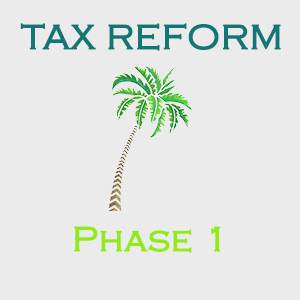The year 2018 is gone and as you may have heard or read, the government has introduced new legislation that will affect your businesses and personal income starting January 1, 2019. In this article we will discuss some of the most important changes that were introduced in this first phase of the tax reform.
BBO/BAZV/BAVP on invoices
This was one of the most discussed changes even before it was officially handled and approved in Parliament. As we mentioned in our BBO vs sales tax article, since the introduction of the BBO, the government pretty much left it to the creativity of businesses as to how they would handle this tax. In that article we explained that businesses had 3 options.
- Businesses could decide not to pass this additional cost to their customers
- Businesses could increase their selling prices to include the additional cost
- Businesses could charge the BBO to their customers as a separate line on their invoices
Invoices
According to new legislation, starting January 1, 2019 businesses are no longer permitted to charge BBO/BAZV/BAVP to their customers as a separate line on their invoices, effectively eliminating the third option we mentioned in above list. For businesses that (1) decided not to pass the additional cost of the BBO/BAZV/BAVP to their customers or (2) increased their selling price to include the additional cost of these taxes, nothing will change in 2019. However, businesses that have been charging the BBO/BAZV/BAVP to their customers as a separate line on their invoices, will have to either absorb the cost or increase their selling prices to include the BBO/BAZV/BAVP.
Grace period
As some businesses have thousands of items that might need to be re-priced in their software and labels that need to be re-printed, the government has introduced a grace period of 6 months. During this period, businesses that are charging the BBO/BAZV/BAVP as a separate line on their invoice will be allowed to continue with this system but are expected to work towards adapting their system to comply with this new legislation by July 1, 2019.
Fines
After this 6 months’ period, businesses that do not comply could face up to a maximum of Awg. 10,000 in fines from the tax authorities.
Income tax
Currently, the income tax is calculated based on a 14-scale income bracket scheme and a tariff group which the tax payer qualifies for. The first Awg. 20,456 of the tax payer’s income was tax free. However, for that part of income which was above Awg. 304,369, the tax payer would pay as high as 58.95% in income tax.
New income brackets
The new legislation has introduced three changes to this calculation:
- The 14-scale income bracket scheme has been reduced to a 4-scale income bracket scheme with corresponding different tax rates (see table below).
- The first part of income which is tax free has been increased from Awg. 20,456 to Awg. 27,751.
- The current two tariff group system has been eliminated and changed into just one tariff group.
As per the above new income bracket scheme the income tax is calculated as follows:
- First you need to calculate the so-called table income by deducting the exemption amount of (maximum) Awg. 27,751 per year from the taxable income.
- If the table income is more than the amount stated in column I, but no more than the amount stated in column II, the tax amount will be the amount stated in column III increased with the amount calculated by taking the percentage in column IV over that part of the table income that is above the amount stated in column I.
Example number 1, take a taxable income is Awg. 36,000 per year.
Table income = Awg. 36,000 -/- Awg. 27,751 = Awg. 8,249
Bracket = 1
Income tax = Awg. 0 +/+ (14% of Awg. 8,249) = Awg. 1,154
Example number 2, take a taxable income is Awg. 75,000 per year.
Table income = Awg. 75,000 -/- Awg. 27,751 = Awg. 47,249
Bracket = 2
Income tax = Awg. 4,702.18 +/+ (25% of (Awg. 47,249 -/- Awg. 33,587)) = Awg. 8,117
As per our calculations, tax payers who were in tariff group 1 with a taxable income Awg. 103,300 and Awg. 373,800 per year will pay more income tax starting in 2019. For tariff group 2 tax payers, the income tax calculated as per the new 4-scale income bracket scheme will be always lower.
Real estate tax
Another change that will affect many businesses and individuals is the new real estate tax calculation basis. Currently, the real estate tax is calculated as 0.4% of the registered value of your property minus an exemption of Awg. 60,000.
For Aruban residents and non-commercial properties, the new legislation has introduced a bracket system with corresponding tax rates based on the value of your property (See table below).
[table id=2 /]For example, if your registered property value is Awg. 180,000, your real estate tax will be: Awg. 180,000 x 0.2% = Awg. 360. With this new bracket system and the elimination of the exemption of Awg. 60,000, any Aruban resident with a non-commercial property with a registered value of above Awg. 500,000 will pay more real estate tax starting in 2019.
Non-residents and commercial properties
In case of non-residents and commercial properties, real estate tax will now be charged at a fixed rate of 0.6% of the registered value of the property. This means that all non-residents and commercial property owners will pay more real estate tax starting in 2019.
Declaration system
Another change in connection with the real estate tax is that it has been changed to a declaration system. Up until the year 2018, tax payers would receive a yearly assessment from the tax authorities with the amount of real estate tax to be paid. The tax authorities would calculate the real estate tax based on information available to them or based on their own observations.
The government has now introduced a new article in the real estate tax legislation that states that (a) anyone who has obtained/acquired a real estate property or (b) anyone who has made significant renovations/changes to real estate property they currently own, has to notify the tax authorities via a declaration within 1 month. The tax authorities will then calculate the tax payer’s real estate tax based on this declaration.
Tax payers who did not receive a real estate tax assessment for 2018 or who received a real estate tax assessment that was knowingly lower than it should have been, must file a declaration no later than April 1, 2019.
Fines
In case the tax payer does not comply with the above-mentioned declaration and this results in a lower real estate tax assessment than it should have been, the tax authorities have the right to impose up to a 100% fine on the amount of the real estate tax that was short paid.



